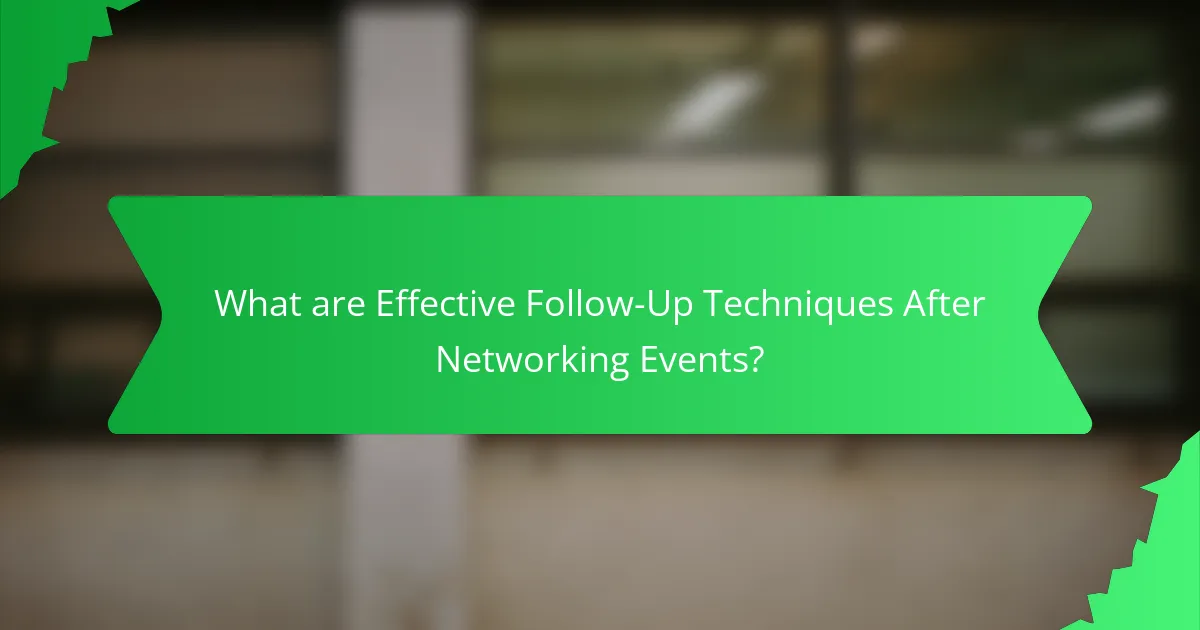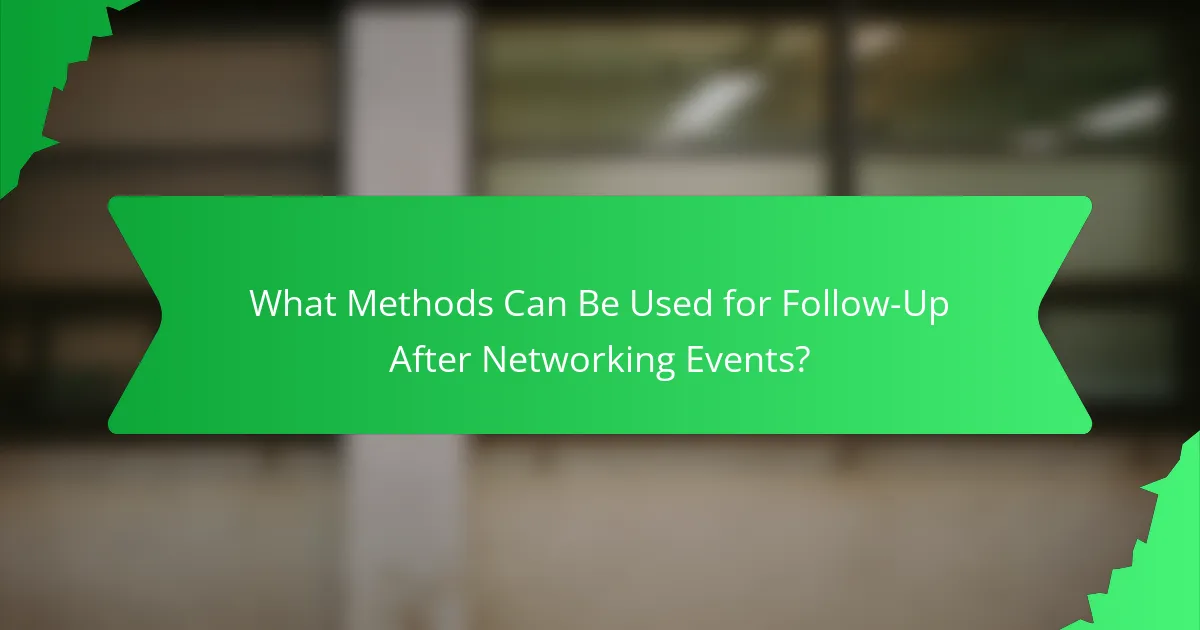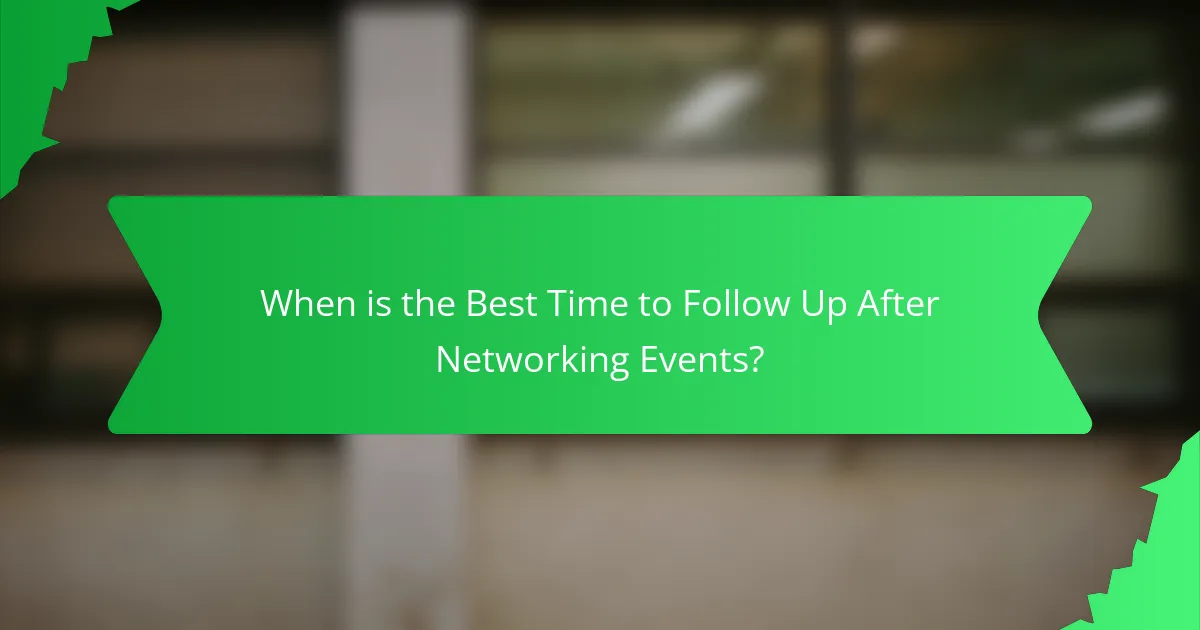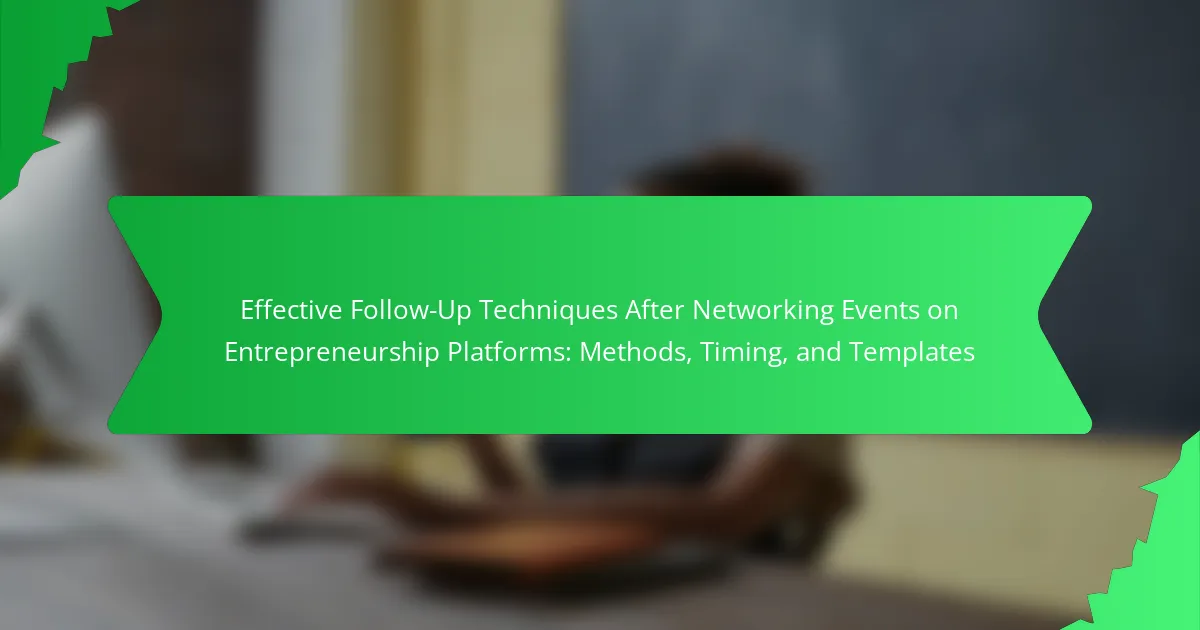Effective follow-up techniques after networking events are crucial for building lasting professional relationships, particularly in entrepreneurship contexts. Key methods include sending personalized emails that reference specific conversations, connecting on social media platforms like LinkedIn for ongoing engagement, and scheduling follow-up meetings within 24 to 48 hours for maximum impact. Other strategies such as phone calls and handwritten notes can enhance rapport and demonstrate thoughtfulness. Research indicates that timely follow-ups significantly increase response rates and the potential for collaboration, making these techniques essential for entrepreneurs looking to strengthen their networks.

What are Effective Follow-Up Techniques After Networking Events?
Effective follow-up techniques after networking events include sending personalized emails, connecting on social media, and scheduling follow-up meetings. Personalized emails should reference specific conversations. This shows genuine interest and helps the recipient remember you. Connecting on social media platforms like LinkedIn can maintain the relationship. It allows for easy sharing of relevant content. Scheduling follow-up meetings can deepen connections. Aim to meet within a week of the event for maximum impact. According to a study by the Harvard Business Review, timely follow-ups significantly increase the chances of building lasting professional relationships.
How do these techniques impact networking success?
Effective follow-up techniques significantly enhance networking success. These techniques foster stronger relationships by demonstrating genuine interest. Timely follow-ups can lead to increased engagement with contacts. Personalized messages show attentiveness, making recipients more likely to respond. Research indicates that 80% of sales require five follow-ups to close, highlighting the importance of persistence. Additionally, consistent communication helps maintain visibility in professional networks. This visibility can lead to referrals and new opportunities. Overall, implementing effective follow-up techniques creates a lasting impression and drives networking success.
What role does timing play in follow-up effectiveness?
Timing significantly impacts follow-up effectiveness. Prompt follow-ups, ideally within 24 to 48 hours, increase the likelihood of engagement. A study by the Harvard Business Review found that contacting leads within an hour increases conversion rates by seven times. Delayed follow-ups can lead to diminished interest and missed opportunities. Timing also reflects professionalism and respect for the other person’s time. The right timing can create a sense of urgency, prompting quicker responses. Therefore, strategic timing is essential for maximizing follow-up success.
How can personalization enhance follow-up communication?
Personalization enhances follow-up communication by making interactions more relevant and engaging. Tailored messages resonate better with recipients. They feel valued and understood when communication reflects their specific interests or previous discussions. Studies show that personalized emails can increase open rates by 26%. This demonstrates the effectiveness of customization in follow-up strategies. Moreover, personalization fosters stronger relationships. It encourages ongoing dialogue and increases the likelihood of positive responses. By addressing individuals by name and referencing past conversations, follow-ups become more meaningful. This approach ultimately leads to improved networking outcomes.
Why is follow-up important in entrepreneurship networking?
Follow-up is important in entrepreneurship networking because it helps to solidify connections made during events. It reinforces relationships and shows genuine interest in collaboration. Entrepreneurs who follow up are more likely to be remembered. A study by the Harvard Business Review states that consistent follow-up increases the likelihood of partnership opportunities. Furthermore, timely follow-up can lead to valuable insights and information sharing. It demonstrates professionalism and commitment to building a network. Effective follow-up can also differentiate an entrepreneur in a competitive landscape.
What are the potential outcomes of effective follow-up?
Effective follow-up can lead to strengthened relationships and increased opportunities. It fosters trust and demonstrates commitment to connections made. Effective follow-up enhances communication, ensuring clarity on discussed topics. It can result in valuable partnerships and collaborations. According to a study by the Harvard Business Review, timely follow-ups can increase the likelihood of securing business deals by 25%. This emphasizes the importance of follow-up in professional networking. Additionally, effective follow-up can provide feedback, helping individuals improve their networking strategies. Overall, these outcomes contribute to long-term success in entrepreneurship.
How does follow-up contribute to building professional relationships?
Follow-up contributes to building professional relationships by reinforcing connections made during initial interactions. It demonstrates commitment and interest in the relationship. A timely follow-up can clarify discussions and address any outstanding questions. This proactive approach fosters trust and reliability. Studies show that consistent follow-up increases the likelihood of collaboration. According to a report by the Harvard Business Review, 80% of sales require five follow-ups after the initial meeting. This statistic highlights the importance of persistence in relationship-building. Additionally, follow-up allows for continued engagement and opens doors for future opportunities.

What Methods Can Be Used for Follow-Up After Networking Events?
Email outreach is a primary method for follow-up after networking events. Sending a personalized email reinforces connections made during the event. It can express gratitude for the conversation and mention specific topics discussed. This approach can lead to stronger relationships and potential collaborations.
Social media engagement is another effective method. Connecting on platforms like LinkedIn allows for ongoing interaction. Sharing relevant content can keep the connection alive and demonstrate continued interest.
Phone calls can also be beneficial. A brief call can personalize the follow-up and clarify any points from the event. This direct communication can enhance rapport.
Sending a handwritten note is a unique method that stands out. It shows effort and thoughtfulness, making the recipient feel valued.
Lastly, scheduling a coffee meeting can provide an opportunity for deeper conversation. This informal setting can foster stronger connections and facilitate future collaborations.
What are the most common follow-up methods?
The most common follow-up methods include email, phone calls, and social media messages. Email is widely used for its formality and ease of tracking. A survey by HubSpot indicates that 86% of professionals prefer email for follow-ups. Phone calls provide a personal touch and allow for immediate feedback. According to a study by InsideSales, 70% of buyers prefer to communicate via phone during follow-ups. Social media messages are increasingly popular for their informal nature and quick responses. LinkedIn reports that 80% of professionals use social media for networking follow-ups. These methods are effective in maintaining connections and fostering relationships after networking events.
How can email be effectively used for follow-up?
Email can be effectively used for follow-up by being clear, concise, and timely. A well-structured email should start with a friendly greeting. It should reference the previous interaction to establish context. Include a specific reason for the follow-up, such as requesting feedback or scheduling a meeting. Keep the message brief to maintain the recipient’s attention. Use bullet points for key information to enhance readability. Additionally, a clear call to action encourages a response. Timing is crucial; sending the follow-up within 24 to 48 hours increases engagement. According to a study by Yesware, timely follow-ups can improve response rates by 50%.
What role do social media platforms play in follow-up?
Social media platforms play a crucial role in follow-up after networking events. They facilitate immediate communication between individuals. Users can send direct messages or connect through professional networks. This immediacy helps reinforce relationships formed during events. Social media also allows for sharing relevant content and updates. Engaging with posts from new contacts keeps connections active. According to a 2020 LinkedIn survey, 85% of professionals use social media for follow-up. This statistic highlights the importance of these platforms in maintaining professional relationships.
How can templates streamline the follow-up process?
Templates can streamline the follow-up process by providing a structured format for communication. They save time by eliminating the need to draft messages from scratch. Templates ensure consistency in messaging, which reinforces brand identity. They help in organizing information, making it easier to personalize follow-ups. Using templates can increase response rates by making outreach more efficient. Studies show that personalized templates can lead to a 50% increase in engagement compared to generic messages. Overall, templates enhance productivity and effectiveness in follow-up communications.
What are key elements to include in a follow-up template?
A follow-up template should include a clear subject line. This line should summarize the purpose of the email. The template should also contain a personalized greeting. Addressing the recipient by name fosters connection.
Next, the template must include a reference to the previous meeting or interaction. This establishes context and reminds the recipient of the connection. It is important to express gratitude for their time or insights. Acknowledging their contributions shows appreciation.
The template should outline the main points discussed. This reinforces the conversation and clarifies any action items. Additionally, it should include a call to action. This prompts the recipient to respond or take the next step.
Finally, the template should have a professional closing. A sign-off with your name and contact information is essential. This encourages continued communication and provides easy access to your details.
How can templates be customized for different contacts?
Templates can be customized for different contacts by adjusting the content to reflect the recipient’s specific interests and relationship. This involves personalizing the greeting, using the recipient’s name, and referencing previous conversations or shared experiences. Tailoring the message to align with the recipient’s industry or role enhances relevance. Additionally, modifying the tone—formal or informal—based on the relationship can improve engagement. Including specific calls to action related to the recipient’s needs or goals makes the template more actionable. Research shows that personalized communication increases response rates by up to 26%.

When is the Best Time to Follow Up After Networking Events?
The best time to follow up after networking events is within 24 to 48 hours. This timeframe ensures that the interaction remains fresh in both parties’ minds. Research indicates that timely follow-ups significantly increase the likelihood of a response. A study by the Harvard Business Review found that contacting leads within the first hour increases the chances of conversion by seven times. Therefore, following up promptly enhances relationship-building opportunities and demonstrates professionalism.
What is the ideal timeframe for follow-up communications?
The ideal timeframe for follow-up communications is within 24 to 48 hours after the initial interaction. This prompt response helps maintain the connection and shows genuine interest. Research indicates that timely follow-ups increase the likelihood of positive responses. According to a study by the Harvard Business Review, contacting leads within the first hour increases the chances of engagement by seven times. Therefore, following up quickly can significantly enhance networking outcomes.
How does the context of the event influence timing?
The context of the event significantly influences timing. Different types of events create varying expectations for follow-up. For instance, a formal networking event may require prompt follow-up within 24 to 48 hours. Conversely, a casual meetup might allow for a more relaxed timeline. The nature of the connections made also matters. If a strong rapport was established, quicker follow-up is advisable. Additionally, the urgency of the discussed topics can dictate timing. If immediate action was suggested, follow-up should occur swiftly. Research indicates that timely follow-up enhances relationship building and opportunities. According to a study by the Harvard Business Review, timely communication can increase the likelihood of successful networking outcomes.
What are the consequences of delaying follow-up?
Delaying follow-up can lead to missed opportunities and diminished relationships. When follow-up is postponed, the initial connection may fade from memory. This can result in a lack of engagement from the other party. Research indicates that timely follow-up increases the likelihood of continued communication. According to a study by the Harvard Business Review, a quick response can enhance relationship-building. Additionally, delays may signal disinterest or lack of professionalism. This perception can deter potential collaborations or partnerships. In a competitive environment, timely follow-up is crucial for maintaining relevance. Overall, the consequences of delaying follow-up can significantly impact networking success.
What strategies can help determine the right timing?
Analyzing audience engagement can help determine the right timing. Review response rates from previous communications. Identify peak engagement times based on past data. Utilize analytics tools to track when your audience is most active. Consider time zones when scheduling follow-ups. Monitor social media activity for optimal posting times. Test different timings to see which yields the best responses. Adjust strategies based on feedback and results from these tests.
How can reminders or scheduling tools assist in follow-up timing?
Reminders and scheduling tools enhance follow-up timing by automating notifications and organizing tasks. These tools can set specific dates and times for follow-ups, ensuring timely communication. They reduce the likelihood of missed opportunities by prompting users when to reach out. Research shows that timely follow-ups can increase response rates by up to 30%. Scheduling tools also allow users to prioritize tasks based on urgency, ensuring that important follow-ups are not overlooked. Overall, they streamline the follow-up process, making it more efficient and effective.
What are best practices for effective follow-up after networking events?
The best practices for effective follow-up after networking events include sending personalized messages. Personalization increases engagement and shows genuine interest. Aim to follow up within 24 to 48 hours after the event. Timeliness keeps the interaction fresh in the recipient’s mind. Use a clear subject line that references the event or conversation. This helps the recipient recall your interaction. Express appreciation for their time and insights shared during the event. Acknowledging their contributions fosters goodwill. Include a specific point from your conversation to reinforce the connection. This demonstrates attentiveness and strengthens the relationship. Offer to provide value, such as sharing relevant resources or insights. Providing value enhances the likelihood of continued communication. Finally, maintain a record of your follow-ups to track interactions and measure effectiveness. Keeping organized records aids in future networking efforts.
Effective Follow-Up Techniques After Networking Events on Entrepreneurship Platforms focus on methods, timing, and templates to enhance networking success. Key techniques include sending personalized emails, connecting on social media, and scheduling follow-up meetings, with an emphasis on timely communication within 24 to 48 hours to maintain engagement. Personalization is highlighted as a crucial factor for effective follow-up, fostering stronger relationships and increasing response rates. The article also discusses best practices for follow-up communications, including the use of templates to streamline the process and the importance of tracking interactions for future networking efforts.
